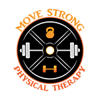How to Get Back to the Deadlift After a Low Back Injury
Returning to the deadlift after a low back injury can be very intimidating. Low back pain can be one of the most frustrating injuries and athlete or gym goer can experience. Returning to training can be a daunting task especially if someone is experiencing low back pain when training.
If you’re experiencing low back pain from deadlifts and are not seeing an improvement in your symptoms, contact a licensed medical professional. To start returning to deadlifting, we want to make sure you can perform a hip hinge correctly. A quick and easy test to use is to place a dowel on your back and see if you can perform correctly.
Hip Hinging With Dowel
When performing, the majority of the movement should come from the hips and slightly from the knees. By placing a dowel on your lower back, this can provide feedback if any of the motion is coming from your lumbar spine.
If the dowel continues to come off of your low back, start practicing this drill and work on keeping the dowel in contact with your head, thoracic spine, and sacrum.
Supine Kettlebell Pullover
Another drill I like to incorporate prior to returning to deadlifting or most other injuries, is the Supine Kettlebell Pullover
This drill is a great starting point to help reinforce good spine position with most any movement. First off, spinal moment does occur to some extent with most lifters. But, this can be a great drill to train any athlete or client on how to maintain a good rib cage position on top of a good pelvic position.
Start by, lying on your back with a 8-10kg kettlebell above you. Take a deep breath in and exhale and as you exhale think of pulling your rib cage down towards your belt line. Then, bring the kettlebell overhead and do not allow your rib cage to pop up towards the sky.
Before each repetition make sure to inhale and exhale and set the rib cage In the position referenced previously.
I like using this drill for most athletes and clients at his is a good way to train good rib cage and spinal position when performing loaded movements. Lots of athletes and clients assume an either rounded back or arched back position when lifting. This drill can help promote good movement habits.
Once you are able to perform the hip hinge with the dowel correctly and perform the Supine Kettlebell Pullover, start performing some loaded hip hinge movements such as:
Cable Pull Throughs
Standing Banded Hip Thrust
Tall Kneeling Banded Hip Thrust
Rack Pulls from Knee Caps
Start performing with light to moderate weight with the technique. If you are able to maintain good technique and movements feel good, gradually add load and perform with good technique.
Once you have performed the movements mentioned above for a few weeks and as long as things are feeling good when performing them, gradually start to increase the weight and/or difficulty of the movements.
If you are performing rock pulls from your kneecaps, start progressing the bar further down towards the floor. Try performing from the upper part of your shin or mid shin.
Throughout this entire process, make sure to maintain good technique. The term “perfect technique” is a myth. Good technique is a range and can vary for most people.
The saying, “if it looks like poop, smells like poop, then it’s probably…“
As you continue to progress towards the floor, you can work on lowering the height of the rack pull and/or progress to a trap bar deadlifts.
Trap Bar Deadlifts
Rack Pulls
If you don’t have access to a trap bar, performing a lower rack pull or elevated deadlifts or deadlifts from blocks can suffice.
Now, once you are feeling good and your technique has been doing well, there are two options when pulling from the floor: conventional and sumo.
Check out my previous post, Which Deadlift Variation is Right for You, to see if conventional, Sumo, or Trap Bar Deadlifts are best.
When you start to pull from the floor, you may need to start with a lighter weight than you are used to pulling for rack pulls or trap bar or compared to what you’ve pulled in the past.
As you begin to pull from the floor, still maintain good technique.
One key factor in all of this is to make sure you were gradually increasing your loading and the work you are performing.
One big problem that most people run into is that they try to progress they’re loading way too quickly. After an injury, gradual tissue loading is key in order to positively stress the body and the tissue, but not to overload it and create a setback or another injury.
One rule I like to use is the law of 10%. The work by Tim Gabbett and others has popularized this and is a good metric for increasing load and work. If you are trying to figure out how much you should increase your weight on the bar, use 10% from the week before and that is a solid metric to help guide you on increasing the weight on the bar.
Returning to pulling from the floor can be intimidating and daunting for some people. If you attempt to pull from the floor and continue to have back pain or continue to re-injure yourself, seek out a licensed medical professional who can properly progress you back to pulling from the floor.
Try following these progressions listed above if you have had low back pain, still do, and are looking to get back to deadlifting in some fashion.
If you are experiencing lower back pain when deadlifting, and it is affecting your training or your daily life, we are here to help. Contact Us to take that first step to get back to doing what you love.



